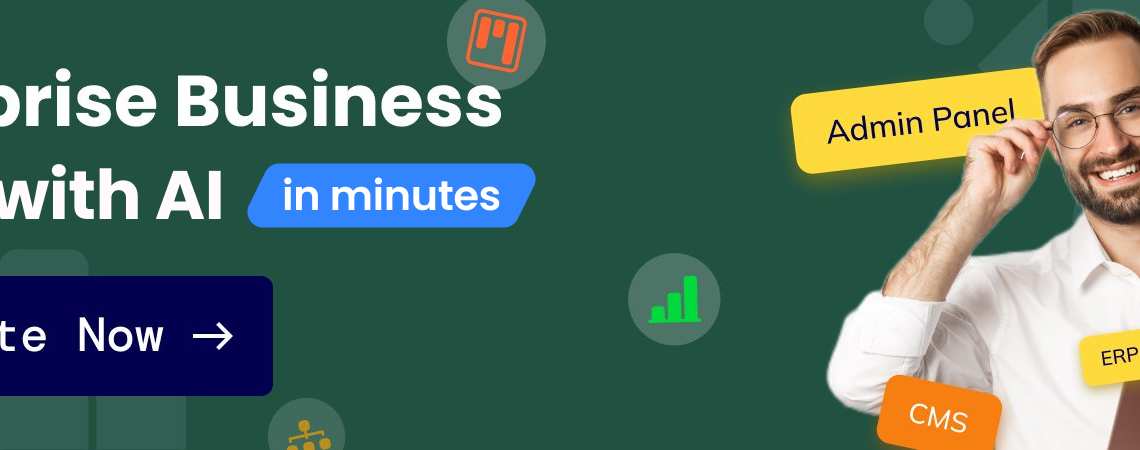
Top 8+ AI Web App Generators [Based on Research Data]
October 10, 2024Choosing the right AI web app generator can make or break your project. Read on to discover the best tools for building scalable, customizable apps quickly and efficiently.
When searching for AI web app generators, you might ask yourself: Which tool offers the best balance between speed and flexibility? Can I customize the app fully? How quickly can I get my MVP up and running?
The rise of low-code/no-code (LCNC) tools has transformed how businesses approach app development. Flatlogic’s research in 2024 shows that over 50% of developers and decision-makers now prefer visual/drag-and-drop builders, while AI-powered tools, like AI web app generators. AI web generators are a brand-new category of tools, representing a highly innovative approach to web development. However, as our research has shown, this category has gained substantial popularity. Developers are beginning to recognize the potential of these tools, and their adoption is growing faster than expected, marking a significant shift in how we approach app building.
Steve Jobs once said, “Innovation distinguishes between a leader and a follower.” Picking the right AI web app generator can give you the edge you need to lead.
Flatlogic has hands-on experience building custom ERP, CRM, and SaaS solutions. Our knowledge comes from real-world projects and research into the latest trends in low-code/no-code tools and AI-powered generators. This combination of practical and research-based insights allows us to offer a clear perspective on how these tools can improve development speed without compromising on customization.
Even though the “AI web app generators” category is new, we hope that by reading this article, you’ll know the top AI web app generators, their features, and which one is right for your project. You’ll also gain insights into how to use these tools to build a fully customizable, scalable web app in record time.
Overview of the Current AI Web App Landscape
AI-driven web app generators, or text-to-app generators, represent a new and innovative category of development tools. These tools combine artificial intelligence with low-code/no-code (LCNC) frameworks, allowing users to create web applications by describing desired features in natural language, which is then automatically translated into functional code. This simplifies the development lifecycle and enables faster deployment without sacrificing customization.

The Role of AI in Solving These Problems
AI has transformed the development landscape by addressing some of the core challenges that have plagued developers for years: speed, customization, and complexity. Traditionally, developers faced a tradeoff – speed often came at the expense of flexibility. With the introduction of AI-powered tools, this is no longer the case. AI enables developers to create highly customizable apps while drastically reducing the time required to get them up and running.
- One of the biggest problems AI solves is reducing repetitive tasks in the development process. AI-driven web app generators streamline workflows by automating common tasks, such as code generation, interface creation, and even back-end configurations. Instead of writing boilerplate code, developers can now focus on the features that make their applications unique, significantly speeding up time to market.
- Moreover, AI enhances flexibility by allowing developers to create more efficient applications that meet specific business needs. Instead of being limited by rigid templates, AI web generators offer a way to automate repetitive tasks while giving developers the control to adjust and refine the details of their apps. This helps developers focus on what matters most: delivering a final product that aligns with the unique requirements of their projects.
- Another key advantage is scalability. AI-driven tools don’t just help with the initial build they also simplify the process of scaling applications as business needs evolve. Whether you need to expand functionality or handle larger user bases, AI-powered platforms make it easier to implement these changes without requiring a complete overhaul of the app’s architecture.
- Finally, AI helps mitigate human error, ensuring that code is optimized and less prone to bugs, which can derail timelines and increase costs. With AI assisting in generating cleaner, error-free code, developers spend less time troubleshooting and more time innovating.
In short, AI-powered tools like web app generators are rapidly reshaping the app-building landscape, offering speed, customization, and scalability that traditional methods often lack. By automating repetitive tasks such as code generation and interface creation, these tools allow users to focus on unique features and reduce time to market without sacrificing flexibility. Flatlogic’s 2024 research highlights a rapid adoption of AI web app generators, which are gaining traction faster than expected among developers (including students), decision-makers, and others.
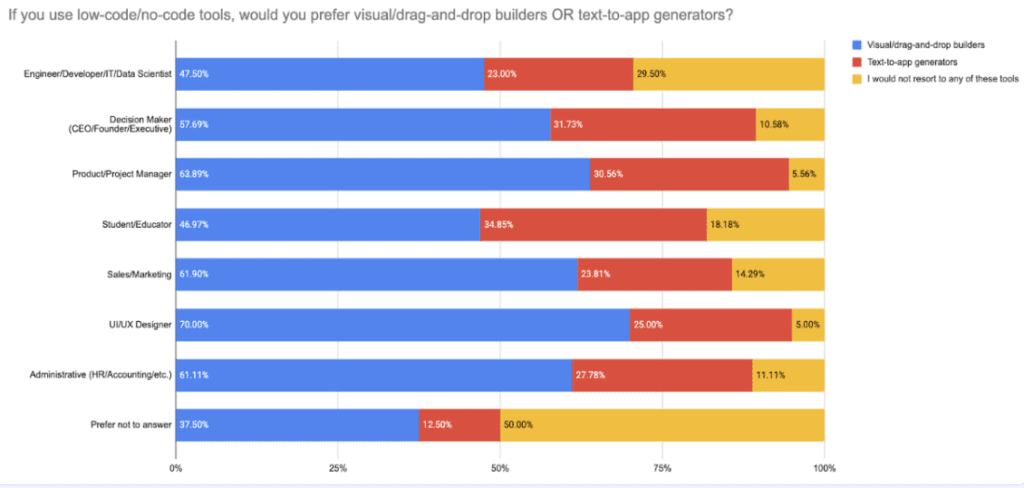
Moreover, these tools reduce human error, leading to cleaner code and enabling developers to prioritize innovation over troubleshooting. The result is a transformative development environment where tailored, high-quality applications are delivered faster than ever before.
Top 8+ AI Web App Generators (Based on Flatlogic Research)
In 2024, Flatlogic conducted research focusing on the preferences for text-to-app generators across different levels of respondents’ experience. The results showed a clear trend towards certain tools depending on the users’ familiarity with development:

So finally, here’s a list of the top AI web app generators:
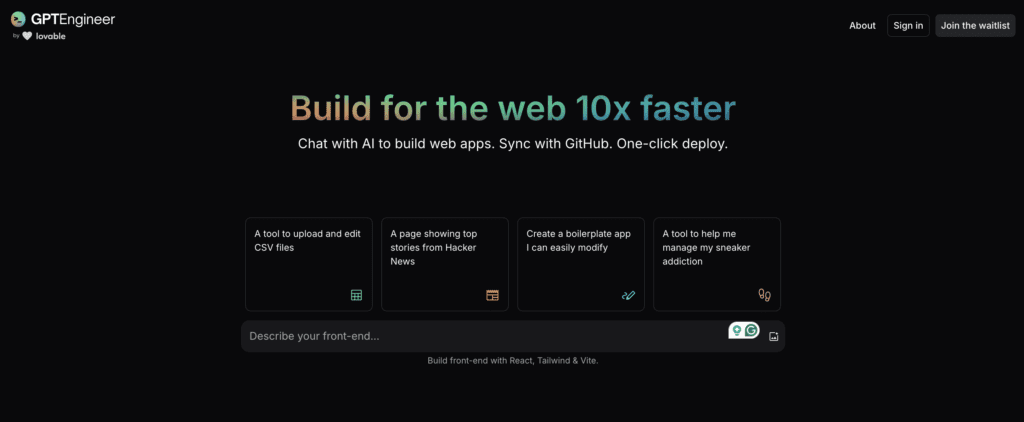
Leading the charge in the text-to-app generator space, GPT Engineer is by far the most popular AI-driven web app generator, with an average of 30.20% across all experience levels respondents. GPT Engineer leverages AI to automate significant parts of the coding process, making it especially appealing to beginners and those looking to expedite development. It’s a tool that stands out for its ability to generate code based on text input, bridging the gap between no-code and more traditional development methods.
Key Features:
- AI-driven code generation from plain language inputs
- Fast setup and deployment
- Best suited for simple applications
Pros:
- Extremely fast app generation
- Beginner-friendly, low learning curve
Cons:
- Limited flexibility for complex apps
- Less control over the final code
Pricing: Free for basic users, paid plans for advanced features
Target Audience: New or less-experienced developers looking for quick, functional app generation with minimal complexity.
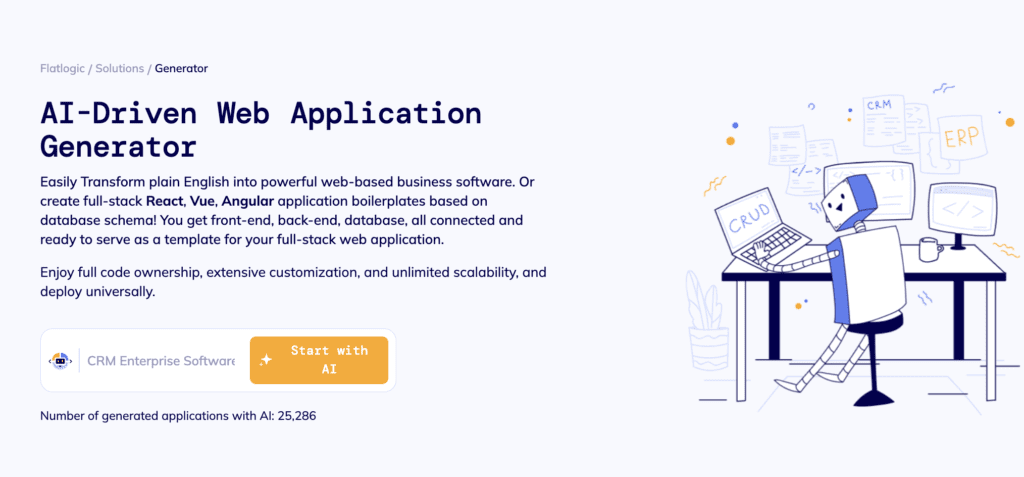
Flatlogic Generator is a top pick, especially for developers looking to balance speed and customization. According to Flatlogic’s research, over 24.75% of respondents who used this tool reported significantly shorter development times while retaining full control over their codebase. It generates customizable MVPs for ERP, CRM, and SaaS apps in just a few minutes while providing access to a scalable and modifiable code structure.
Key Features:
- Rapid generation of full-stack web apps
- Customizable codebase with support for React, Vue, and Angular
- Integration with popular databases like MySQL and PostgreSQL
- Allows full access to the generated code for further modification
Pros:
- Fast setup for complex web apps
- Full access to the source code, ensuring flexibility
- Well-suited for enterprise-level projects
- Supports modern front-end frameworks
Cons:
- Advanced customization may require developer expertise
- Limited pre-built templates compared to competitors
Pricing:
- Free version available
- Paid plans start at $49 per month for advanced features
Target Audience:
- Small to medium businesses, startups, and enterprise developers looking to create highly customizable, scalable apps.
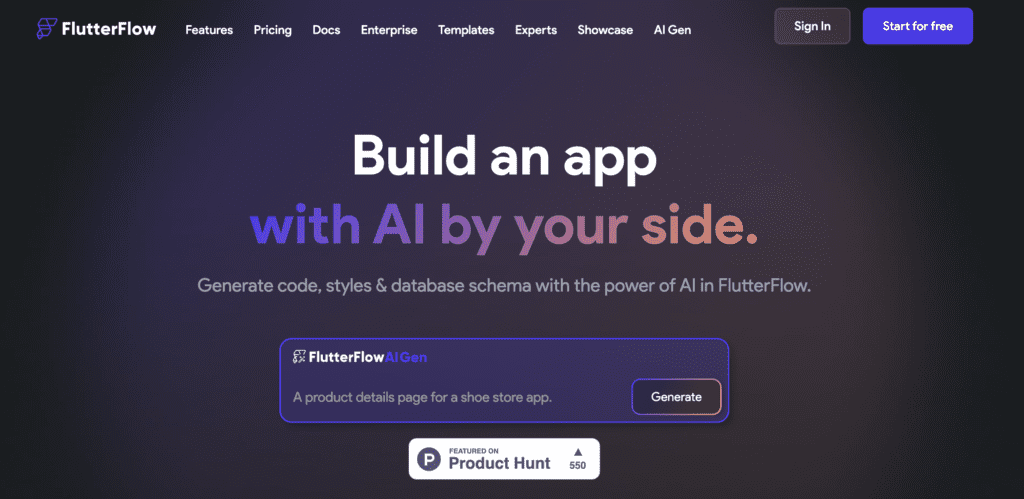
Rounding out the top three is FlutterFlow AI Gen, an average selection percentage of about 15.33%, a tool that integrates AI with Flutter’s already robust framework to offer a powerful low-code solution. FlutterFlow AI Gen is particularly popular among users who appreciate the flexibility of Flutter combined with the efficiency of low-code development. It’s a tool that appeals to developers looking to accelerate their workflow and those new to app development.
Key Features:
- Drag-and-drop interface for Flutter-based development
- Mobile-first, but supports web apps as well
- Simple, intuitive UI for faster builds
Pros:
- Perfect for mobile and cross-platform apps
- Easy-to-use interface for rapid development
Cons:
- Limited to the Flutter ecosystem
- Not ideal for apps requiring complex back-end logic
Pricing: Free plan available, premium features starting at $30/month
Target Audience: Developers focused on mobile-first or cross-platform app development who prefer using the Flutter ecosystem.
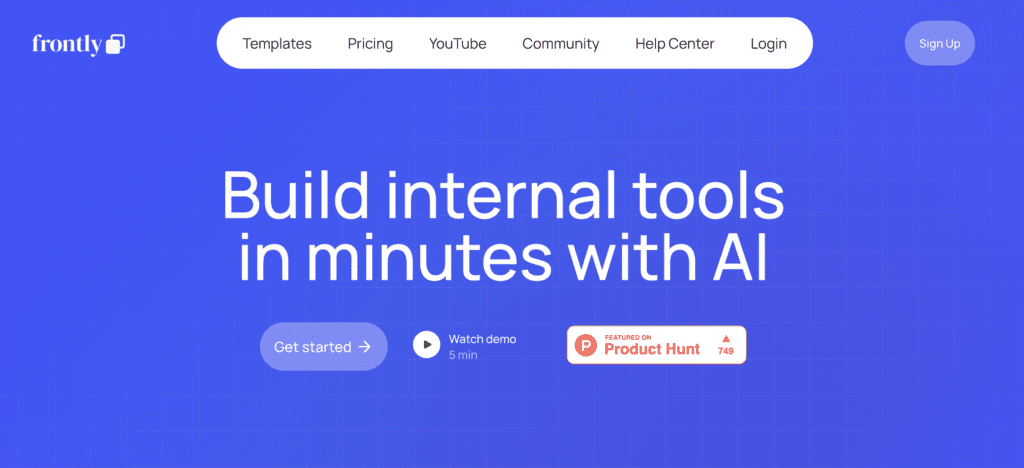
Frontly.ai is a front-end-focused AI web app generator with an average of 12.11% across all experience levels. Frontly.ai makes it easy for non-technical users to build front-end applications quickly. While it focuses primarily on front-end customization, it still offers enough flexibility to get basic apps up and running with minimal effort.
Key Features:
- Front-end customization
- Easy-to-use interface for beginners
Pros:
- Flexible front-end design options
- Beginner-friendly
Cons:
- Limited back-end features
Target Audience: Developers focusing on front-end customization with some technical experience.
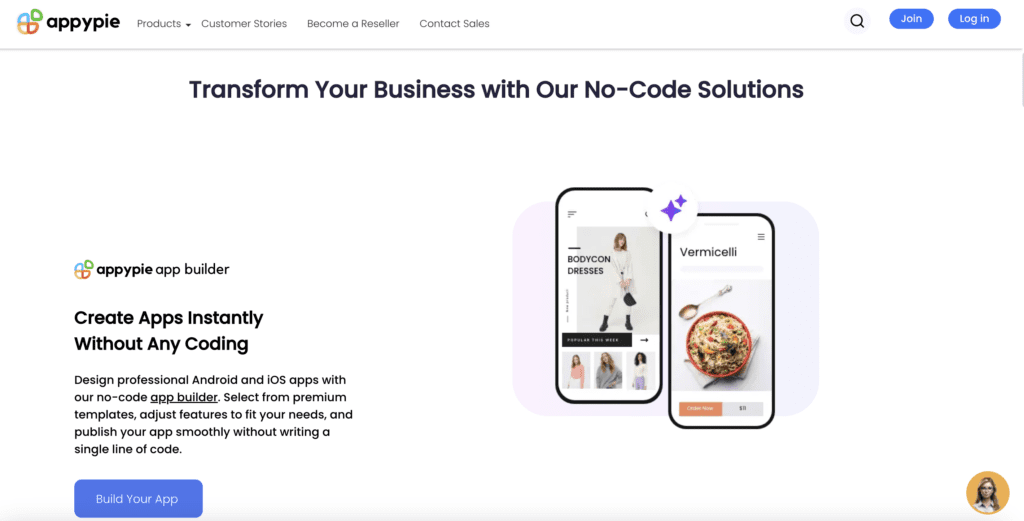
AppyPie has an average selection percentage of 9.85%. Its drag-and-drop interface allows users to build apps without any coding knowledge. AppyPie is particularly popular for small businesses and individuals looking to quickly create simple applications or prototypes.
Key Features:
- Drag-and-drop builder with pre-built templates.
- Cloud-based platform for app creation.
- Supports simple app deployment for both mobile and web.
Pros:
- Easy to use with a highly accessible drag-and-drop interface.
- Fast app creation without technical knowledge.
Cons:
- Limited flexibility for more complex apps.
- Not ideal for developers looking for deep customization or scalability.
Pricing: Free tier available premium plans start at $18/month.
Target Audience: Beginners, small businesses, and non-technical users who need to create simple apps quickly without dealing with code.
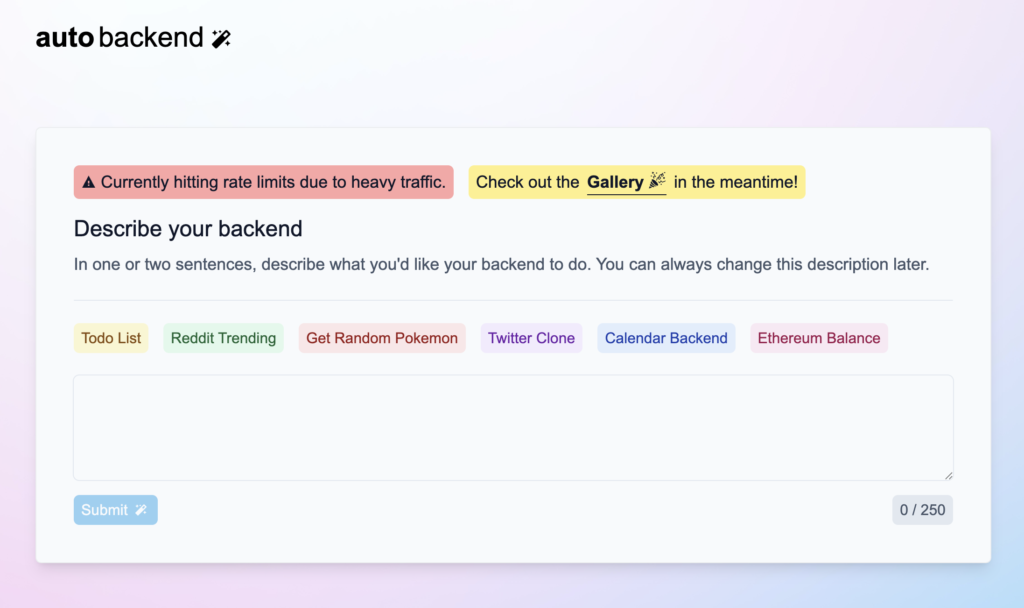
With an average selection percentage of 9.69%, autobackend.dev is designed to automate the creation of back-end services. It allows developers to set up a functioning back-end without manual coding, making it a top choice for developers looking for a simple way to build the back-end without needing to learn advanced coding.
Key Features:
- Fully automated back-end generation.
- No-code interface for creating back-end services.
- Easy integration with front-end platforms.
Pros:
- Quick setup for back-end development without the need for coding.
- Saves time for developers focused on front-end development.
Cons:
- Limited in terms of customization for more complex back-end workflows.
- Not suited for large-scale, highly-customized applications.
Pricing: Free plan available, with premium plans offering more advanced features.
Target Audience: Developers who want a no-code solution for back-end services, particularly those focusing on front-end-heavy projects.
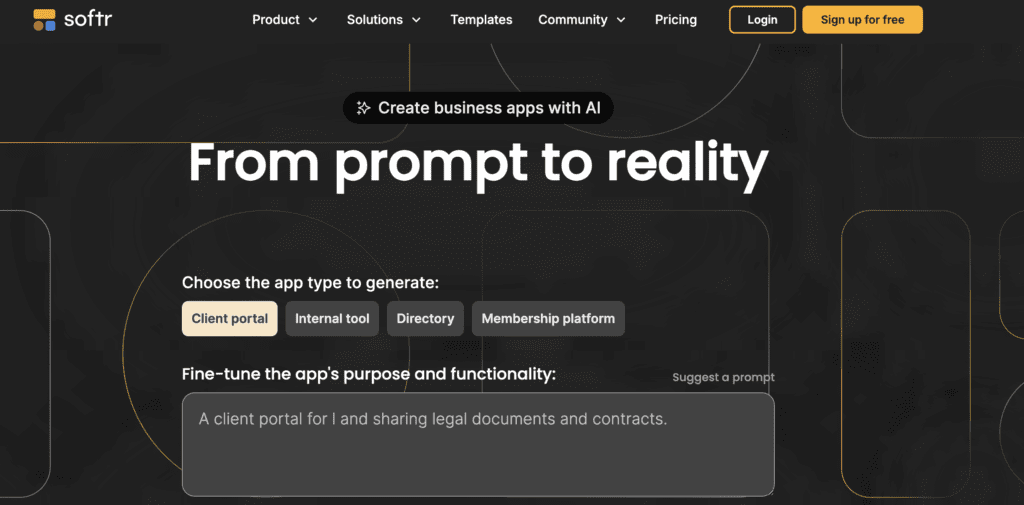
Softr.io holds an average selection of 6.98% and is especially popular for its no-code platform that integrates easily with Airtable. Softr.io allows developers to build simple, data-driven apps quickly, making it a preferred tool for teams focused on internal tools and dashboards.
Key Features:
- No-code app development with Airtable integration.
- Pre-built templates and components for fast app creation.
- Suitable for building data-driven apps or internal tools.
Pros:
- Quick and easy app creation for non-technical users.
- Seamless integration with Airtable for data management.
Cons:
- Limited scalability for larger or more complex apps.
- Not ideal for developers seeking deep customization or complex workflows.
Pricing: A free plan is available, with premium features starting at $24/month.
Target Audience: Teams or individuals looking to create data-driven apps, internal tools, or dashboards without coding, particularly those who rely on Airtable for data management.
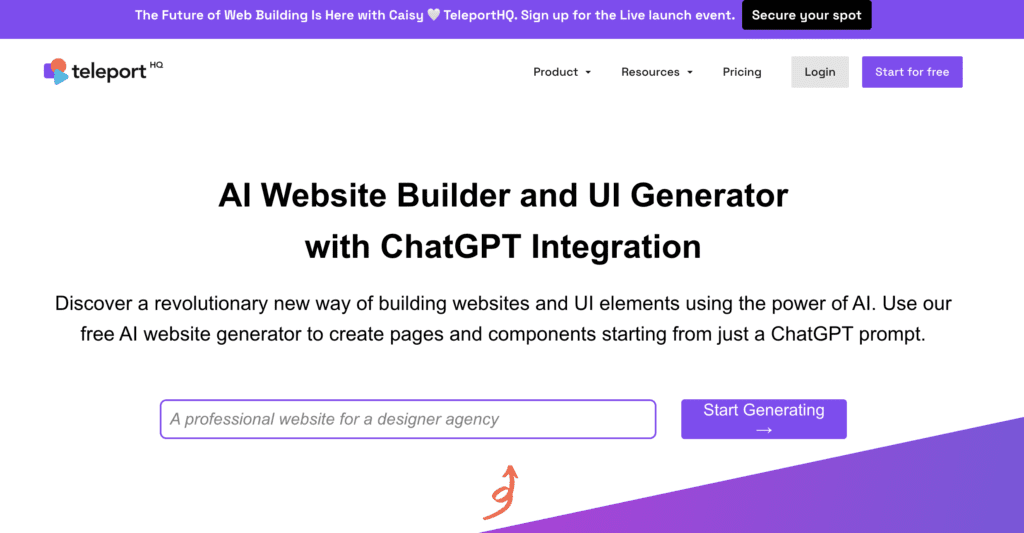
Teleporthq.io, with an average selection of 5.04%, is an AI-powered website-building platform. Teleporthq.io allows users to quickly build and deploy websites with pre-designed templates, making it particularly popular for beginners who want to avoid coding altogether.
Key Features:
- AI-driven website builder with a simple, intuitive interface.
- Pre-designed templates for fast setup.
- Built-in hosting and deployment options.
Pros:
- Very accessible for beginners with no coding skills.
- Fast website creation and deployment.
Cons:
- Limited customization for advanced or complex websites.
- Not suited for applications requiring heavy back-end logic.
Pricing: Free plan available, with premium plans starting at $10/month.
Target Audience: Beginners, small businesses, or individuals looking for a quick and simple way to build and deploy websites without the need for technical expertise.
How to Choose the Right AI Web App Generator for Your Project
When selecting an AI web app generator, it’s essential to consider various factors that will affect both your project’s immediate success and long-term viability. The choice of tool can significantly impact each phase of the Software Development Life Cycle (SDLC) – from planning and design to deployment and maintenance. Here are the key points to guide you in making the right choice:
Define Your Project Scope
The first step in selecting an AI web app generator is understanding the scope and complexity of your project. Are you looking to quickly create a Minimum Viable Product (MVP), build a scalable enterprise-level application, or something more specific like a CRM, ERP, or SaaS platform? Different AI web app generators excel at different use cases:
- Simple MVPs: Some generators focus on rapidly producing MVPs with limited features and fast deployment.
- Complex or Enterprise Apps: Others cater to more advanced use cases where scalability, customization, and long-term maintainability are priorities.
Be clear on your project’s requirements, as this will influence which AI web app generator can meet your needs effectively without limiting future growth.
Customization Flexibility
One of the most critical features to look for in an AI web app generator is the level of customization it allows. While some tools will generate code that’s locked in or difficult to modify, others provide full access to the underlying source code, giving you complete control to make changes as necessary.
- Limited Flexibility: Some platforms are built for no-code users and may not allow you to go deep into the code for modifications.
- Full Customization: Others offer the code in a modular or clean format, enabling teams to add features or integrate more advanced functionality as needed.
Choose a tool that matches your team’s technical capabilities and your need for customization down the road.
Tech Stack Compatibility
Tech stack alignment is essential for seamless integration with your existing systems or your team’s expertise. If your team already works with certain technologies, like React, Angular, or Node.js, make sure the AI web app generator supports these frameworks. Otherwise, you may end up with a solution that requires retraining your team or adapting to new, unfamiliar technologies.
- Front-end and Back-end: Many AI web app generators focus on specific front-end or back-end technologies, so select one that matches your desired stack.
- Database and Infrastructure: It’s also important to verify the database systems (e.g., MySQL, PostgreSQL) and hosting infrastructure (e.g., AWS, Azure) the generator integrates with.
Matching your AI web app generator to the tech stack you’re familiar with ensures easier development and faster onboarding.
Speed vs. Code Quality
While speed is often one of the main selling points of AI web app generators, it’s important not to sacrifice quality for speed. Some tools can churn out apps in minutes, but the code might be bloated or unstructured, requiring significant clean-up and optimization. Look for AI web app generators that not only produce apps quickly but also deliver high-quality, readable, and maintainable code.
- Quality Check: Test the output by examining the generated code – look for simplicity, modularity, and whether it follows best practices for security and performance.
- Trade-off Decisions: Some tools might be optimized for rapid prototyping but require refactoring for production-level use.
Ultimately, you want a tool that strikes the right balance between fast delivery and robust code quality.
Integration Capabilities
Your project may need to interact with other services, APIs, or legacy systems. Choose an AI web app generator that allows easy integration with third-party APIs or supports the protocols you need for data transfer, authentication, and other critical functions.
- API Integration: Ensure that the platform supports REST, GraphQL, or other necessary protocols to connect to external services.
- External Tools: If your project relies on services like payment gateways, CRMs, or external databases, make sure the AI web app generator can easily hook into these systems without needing extensive rework.
Choosing an AI web app generator with strong integration capabilities will save you time and hassle when connecting to external systems.
Ownership and Control of Code
Code ownership is often a grey area with many AI web app generators, especially with low-code/no-code platforms. Some platforms might allow you to export your code only as long as you maintain an active subscription. Others might limit the flexibility of what you can do with the generated app.
- Full Ownership: Ensure you own the code and can modify or deploy it independently, even after you stop using the AI web app generator service.
- Vendor Lock-in: Avoid platforms that create dependency on their system for updates, deployments, or modifications, as this can lead to higher long-term costs.
Opting for an AI web generator that grants you full control over the source code ensures you’re not tied down by vendor constraints.
Scalability
If your project is expected to grow, you need an AI web app generator that can produce scalable applications. This means the architecture should support the addition of new features, handle increased user loads, and accommodate a growing database without needing a complete rebuild.
- Code Structure: Check if the generated code follows scalable patterns like microservices, or if it can handle modular feature additions without breaking.
- Cloud Integration: Make sure it integrates well with cloud platforms for hosting and scaling as your user base grows.
Choosing an AI web app generator that supports scalability from the start can save you from a costly overhaul later on.
Community and Support
A tool with an active community or strong support system can be a game-changer when it comes to troubleshooting or expanding your app. A good AI web app generator will come with detailed documentation, tutorials, and an engaged community that can help with common issues.
- Official Support: Ensure the platform offers customer support, especially if your project timeline is tight and you may need immediate help.
- Community Resources: Check if there are active forums or third-party tutorials that can assist in case you face obstacles during development.
The availability of robust support ensures that your project doesn’t stall due to technical difficulties.
Pricing and Long-term Costs
Finally, carefully evaluate the pricing models of different AI web app generators. Some offer free or affordable plans for basic projects but may charge significantly for advanced features, more users, or higher traffic volumes. Be mindful of long-term costs, especially if your project is expected to grow.
- Subscription vs. One-time Payment: Compare whether the platform uses a subscription model, charges per app, or has a one-time purchase cost.
- Hidden Costs: Investigate if additional fees apply for hosting, scaling, or accessing certain features.
Ensure that the total cost aligns with your project’s budget and that there won’t be unexpected financial surprises as you scale.
Choosing the right AI web app generator is about more than just speed or ease of use. It’s a critical decision that will affect your app’s future scalability, flexibility, and long-term success. By considering these factors, you can ensure that your chosen AI web app generator is aligned with both your current project needs and your vision for its future growth.
Conclusion
Choosing the right AI web app generator is key to ensuring your project’s success and scalability. Tools range from beginner-friendly options like GPT Engineer and FlutterFlow AI Gen, which prioritize speed and simplicity, to more advanced platforms like Flatlogic Generator, which offer greater control over the code and deeper customization. Whatever your needs, there’s a tool that fits your development goals.
Ultimately, the best choice depends on your specific goals. If you’re looking for a fast MVP or a simple, non-technical build, a no-code tool may be perfect for you. However, if control, customization, and scalability are critical for long-term growth, investing in a more flexible platform will pay off in the end.
By taking into account factors such as speed, customization, technical expertise, code control, scalability, and budget, you can select the AI web app generator that best aligns with your project’s vision. Whether you’re building a prototype or an enterprise-level application, the right tool will save you time, reduce costs, and enable you to focus on building what matters – great products.
If you’re looking for a solution that balances speed, flexibility, and full control over your business software, so Flatlogic Generator is the right choice for you. If you need any assistance or have questions, please don’t hesitate to contact us!
